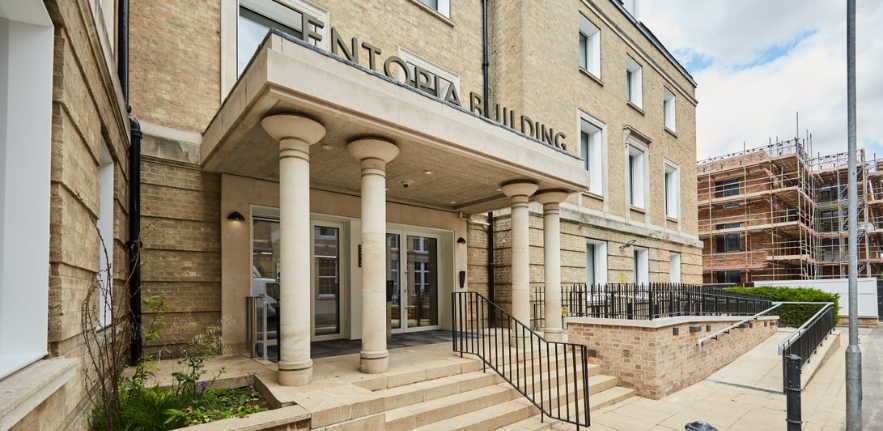
Submitted by Alice Cronshaw on Tue, 09/08/2022 - 13:55
10 August 2022 - The Entopia Building has been awarded the prestigious EnerPHit Classic certification by the Passive House Institute, a significant moment for a project that has transformed a 1930s telephone exchange into an ultra-efficient office-space meeting the highest possible sustainability standards.
Requiring just 15 per cent of the energy requirement of the original building, and saving over 62,000kg CO2e in construction materials, the Entopia Building is the new headquarters for the University of Cambridge Institute for Sustainability Leadership and seeks to offer an exemplar sustainable retro-fit.
The EnerPHit standard, administered by the Passive House Institute, recognises highly energy-efficient retrofitted buildings that achieve superior energy-saving performance. Only a handful of office buildings in the UK have been awarded the standard given its stringent specifications.
Welcoming the announcement, CISL's Chief Operating Officer Anna Nitch-Smith said:
"The EnerPHit standard represents a remarkable achievement for the Entopia Building and has been made possible through the close collaboration of our outstanding project team and friends and partners across the University and City of Cambridge. We are already immensely proud of the outcomes achieved and look forward to sharing the knowledge gained during the project’s execution.”
Wendy Bishop, Associate at Architype, said:
“To achieve EnerPHit certification is a major milestone in the renewal of Entopia as an ultra low carbon, inspiring and healthy place to work. It reflects great teamwork and collaboration from the whole client, design and contractor team and enhances the building’s exemplary sustainable approach.”
Patrick Watson, Partner at 3PM, said:
“The challenge was set; the team aligned, and the goal achieved not something that happens with ease. Following opening up of the structure the redesign has proved that exceptional infiltration rate of 0.6 ACH can be achieved from old structures. A truly world class performance from a highly dedicated team that will stand the test of time as an exemplar for refurbishment schemes in the future”
Gwilym Still, Passivhaus Director at Max Fordham, said:
“For us, as Passivhaus designers, the Entopia building is a dream project, with an engaged client, a forward-looking brief, and a design and delivery team committed to building for the climate emergency. The transformation of the building has been remarkable, including cutting air leakage by 80 per cent, replacing glazing to reduce heat loss, enhance daylight and views, and using bio-based insulation to deal with the challenges of internally insulating against masonry. We’re looking forward to learning more from the in-use data, and sharing this with the wider built environment community. Although it’s an exceptional project at the moment, the approaches, technologies and materials are scalable, so we hope it becomes the norm.”
Lucy Townsend, Head of Sustainability at BDP, said:
“The measures we have incorporated in this groundbreaking project go far beyond standard sustainable buildings and the integrated and collaborative approach to design, operation and management from all stakeholders has resulted in a truly efficient, world class facility. The Entopia Building stands tall as an industry exemplar and achieving EnerPhit certification is hugely significant; demonstrating how we can successfully repurpose existing buildings to be low carbon and highly efficient in both construction and operation.”
Peter Kelly, group director of sustainable operations at ISG, said:
“The opportunity to work on a pioneering project with a group of stakeholders fully aligned to pushing the boundaries for sustainable deep retrofit shows how our industry can effectively collaborate to rise to the climate challenge. An air permeability rate of 0.6m3/hm2 is an excellent result for The Entopia Building and our rigour in documenting the approach, methodology and subsequent operational performance of the building sets a benchmark and serves as an international exemplar for ethical and sustainable refurbishment of existing property assets.”
Eve Waldron, Director at Eve Waldron Design said:
“It has been wonderful being a part of this highly successful exemplar retrofit project. It challenged and expanded our understanding of what is possible with EnerPHit and the wider sustainability achievements. Through successful collaboration, and working with local suppliers and professionals we walked the talk.”
Prof John French, CISL Fellow and Advisor to the Entopia Building project said:
“The team has delivered a world class deep retrofit, true to the original vision and intent that has achieved the impressive standards of Enerphit and they have done this as a connected and collaborative team that has overcome difficult challenges that you would not encounter in a new build project. This team has demonstrated that there is a positive path in retrofitting our old building stock as part of the climate challenge. This represents important technical leadership to the sector supported by CISL and the University of Cambridge.”
The Entopia Building seeks to achieve two more highly demanding sustainability standards: BREEAM Outstanding and WELL (Gold), which would represent a world-first achievement.
CISL's staff will be moving into their ultra-efficient new offices in September, at which point a comprehensive case study will be published to share the outcomes and learnings of the project and promote future sustainable building projects and practices.
What is EnerPHit Certification?
EnerPHit is a standard specific to retrofit of existing buildings and is awarded by the Passivhaus Institute. The Institute was set up by a German physicist – Dr Wolfgang Feist - in the 1990s. Feist asked a seemingly simple question – can we go back to first principles and use a scientific approach to stopping our buildings wasting so much energy?
The institute came up with a solution that is so effective that the need for central heating is almost eliminated; the heat from the sun, occupants and appliances is enough to keep a building warm during much of the winter.
The standard has been described as accountancy. A giant spreadsheet called the Passive House Planning Package (PHPP) is used to calculate everything: heat flow through walls, roof, windows and floors; heat loss through ventilation; heat gains from the sun on windows; and energy used by every appliance and system in the building.
To receive EnerPHit certification the designers and builders had to demonstrate the following:
-
That a continuous wrap of insulation had been added to the inside of every single external surface (computer modelled, photographed during installation, and thermally imaged to prove there were zero gaps).
-
All windows were triple glazed and calculations showing that the window arrangement would minimise risk of overheating, despite only a small amount of mechanical cooling being allowed.
-
An extraordinary level of air-tightness, around 80% less leaky than recent typical new builds (and this for a 1930s building!). This has been tested by pressurising the whole building to 50 Pascals.
-
A guarantee of fresh air using a very efficient mechanical ventilation system that recovers the vast majority of heat from the exhaust air in winter. You can still open the windows, but shouldn’t need to.
-
That the above measures will mean the building requires less than 25kWh/m2 per year of energy to heat (around 80% less than a typical building on the University Estate).
-
That the efficiency of all energy consuming systems and appliances is such that when everything is added up the demand for non-renewable primary energy from the UK grid is less than 74kWh/m2 per year.




